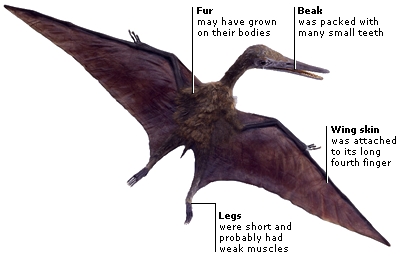DK Science: Up In The Air
Soaring high above the land-living dinosaurs were the pterosaurs, which means “winged reptiles”. The pterosaurs were relatives of dinosaurs, but they were not dinosaurs themselves. All had slim, hollow bones and wings made of skin that stretched between long finger-bones and the legs. Pterosaurs first appeared at the same time as the dinosaurs and lived alongside them until they too died out at the end of the Cretaceous Period. They were the supreme rulers of Earth’s prehistoric skies, flapping their wings over land and sea.
Pterodactylus was an agile flyer which probably fed on insects. Unlike other pterosaurs that had long tails, the tail of Pterodactylus was little more than a short, stubby point. Just 30 cm (12 in) long, it had a lightly built skeleton and thin, hollow bones. Perhaps these weight-saving features were designed to give Pterodactylus greater flight control, helping it to fly fast and giving it the ability to swoop and turn with ease.
This fossil skeleton embedded in limestone shows Pterodactylus’s delicate skull and fine bones. The pterosaur’s four fingers can be seen clearly. Three fingers on each of its hands were short and hook-like, and it is possible they were used for defence. The fourth finger can be seen here running diagonally from the hand on the right to the leg on the right. Pterodactylus’s wings were attached to each of these extremely long fingers and its legs.
Pterodactylus belonged to the Pterodactyloid branch of the pterosaur family tree. These pterosaurs all had short tails.
| Lived: 140 million years ago (Cretaceous) |
| Habitat: rivers, seas, lakes |
| Wingspan: up to 1.8 m (6 ft) |
| Length: up to 30 cm (12 in) |
| Diet: fish, insects |
Several species of pterosaur sported crests on their heads and beaks. They were made from hard bone or soft tissue. It is not yet known if the crests were grown by males or females, or by both sexes. Their function is also uncertain. As the shape, size, and possibly the colour of crests differed between species, they may have helped pterosaurs recognize their own kind. They may also have been used in courtship displays or as stablilizers during flight.
Much can be learned about pterosaurs’ lifestyles by studying today’s animals that appear to share similar characteristics with them. Although pterosaurs were not birds, their fish-eating habit can be compared with that of modern pelicans. Many pterosaurs had long, narrow heads and throat pouches like modern pelicans. Perhaps, like pelicans, these pterosaurs were plunge-divers, grabbing fish by thrusting their beaks below the water’s surface.
To order this book direct from the publisher, visit DK's website.






